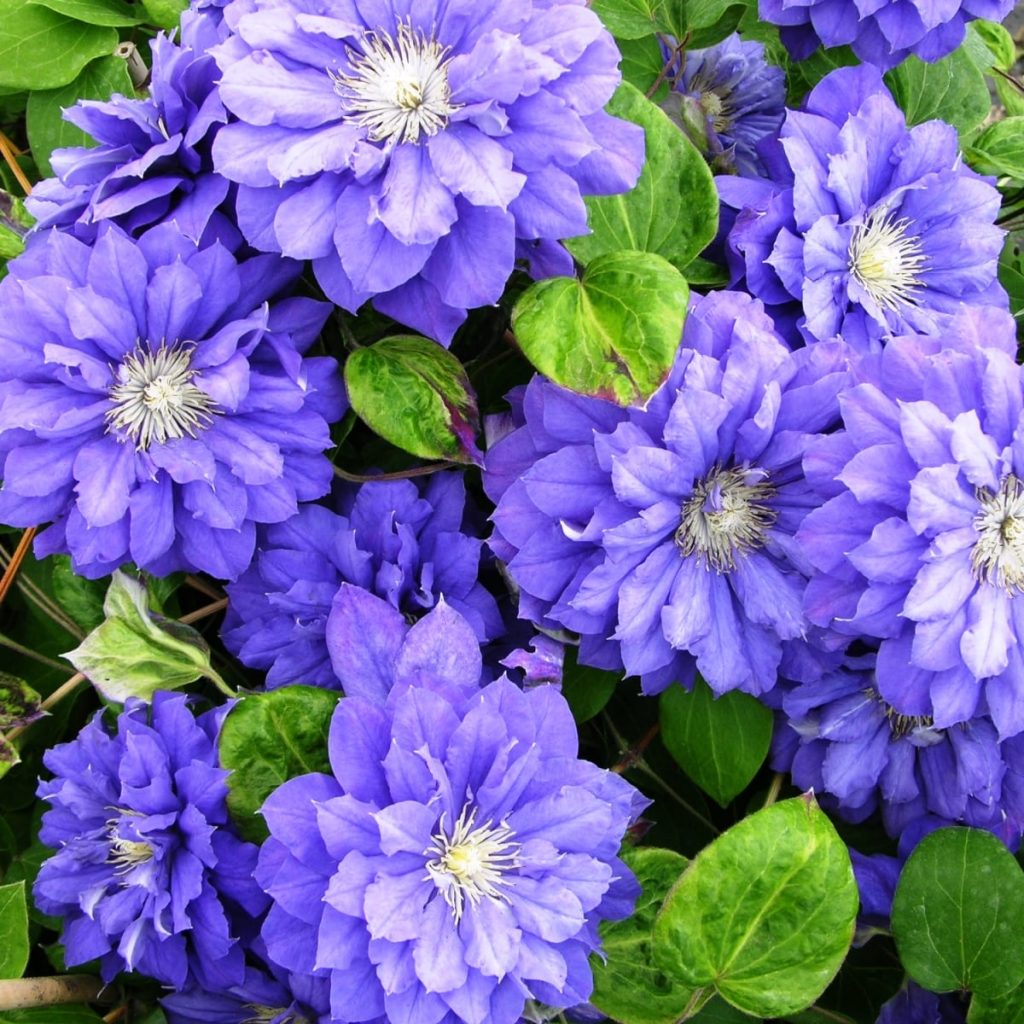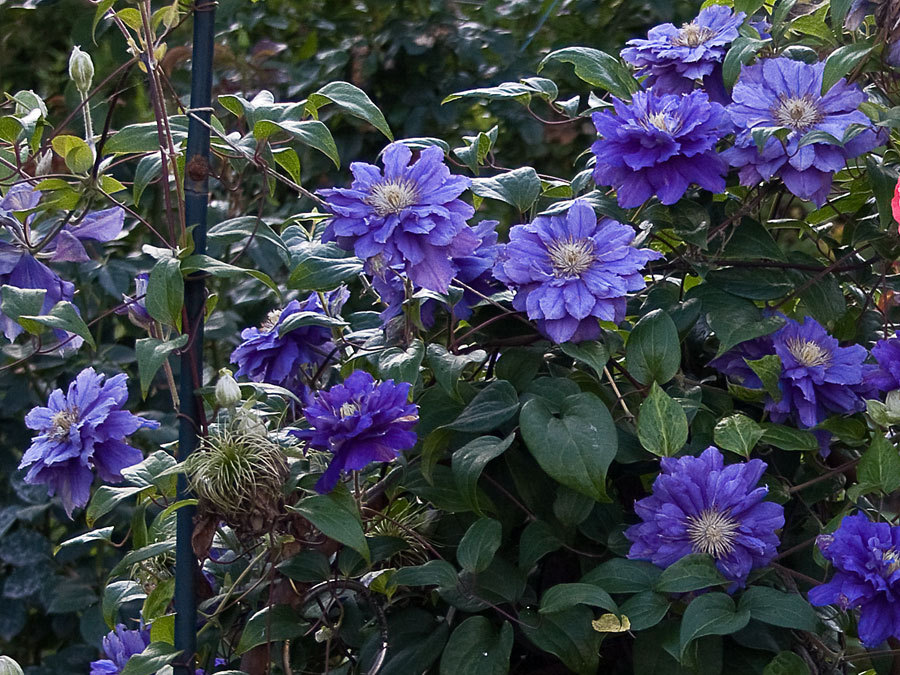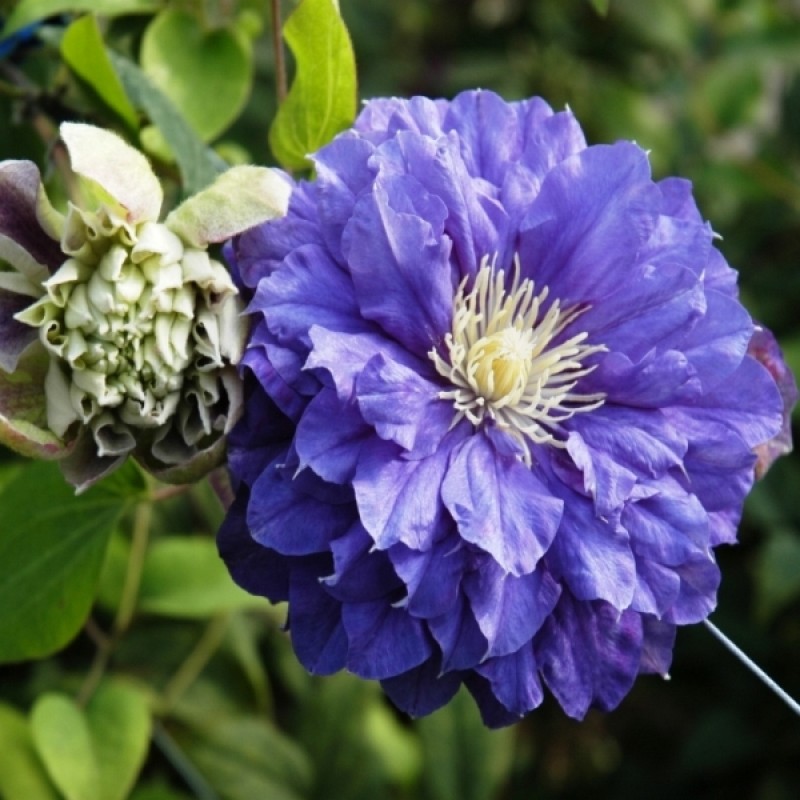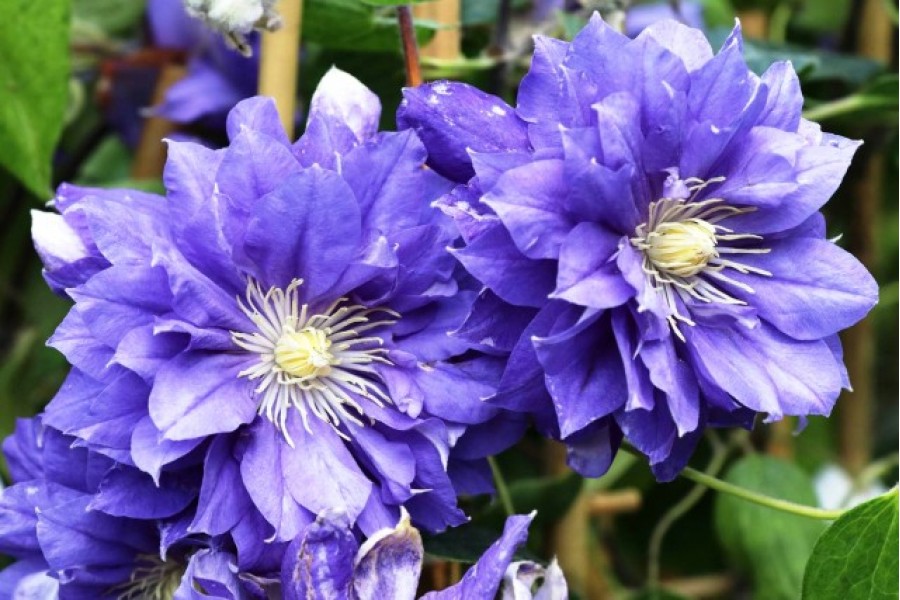Description, rules for planting and caring for clematis kiri te ditch
The perennial beautifully blooming clematis Kiri Te Kanawa was bred in 1986 and named after the famous opera singer who sang at the wedding of Lady Diana and Prince Charles. Originator - Barry Fretwell, UK. Consider the main features of a decorative liana, the rules of planting and care.
- General characteristics
- Landing rules
- Place and soil
- Seedling preparation
- Landing technology
- Care features
- Watering
- Top dressing
- Pruning
- Preparing for winter
- Reproduction methods
- Cuttings
- Stem layering
- By dividing the bush
- Diseases and pests
- Rust
- Powdery mildew
- Wilt (wilting)
- Nematode
- Aphid
- Slugs and snails
- Application in garden design
- Variety reviews
- Useful videos

Clematis kiri te ditch
General characteristics
Clematis Kiri Te Kanawa (lat.Klematis Kiri Te Kanawa) belongs to the group of early large-flowered varieties.
Due to its good degree of frost resistance (zone 4-9), this large-flowered variety is suitable for cultivation in the Central and Middle zone of our country, as well as in the southern regions.
The plant has a moderate vigor of growth - in a year the shoots stretch up to 10 cm.
External parameters:
- curly stems - up to 3 m in length, require support;
- leaves are green, oval, with a sharp tip, densely cover the branches;
- inflorescences are large - up to 15 cm in diameter, consist of dark blue double petals arranged in several rows;
- repeated flowering - the first from May to June, the second from July to August;
- the root system is well developed - branched, develops close to the soil surface.
Landing rules
In the south and in the Middle Lane, clematis are planted in spring (early or mid-April) or early autumn - in the first half of September.
In regions with a harsh climate, short summers and unstable weather, planting is carried out in the second or third decade of April.
The main thing is that the seedlings do not start growing, the soil warms up to 10-12 ° C and the last frosts pass.
Place and soil
For rapid growth, lush and long-lasting flowering, perennial liana requires good lighting. Choose a place where there is sunshine in the morning and evening hours. At lunchtime, shading will be required so that the leaves and inflorescences do not dry out.
This is a climbing plant, so you need to plant it next to vertical structures or any support along which the stems can climb to the top without obstacles.
The soil is suitable for light, well-drained, enriched with mineral and organic components. The optimum acidity level is 6-7 units. If necessary, add a deoxidizer - for 1 m² 400 g of calcite, chalk or hydrated lime.
When planting seedlings in heavy clay soil, a baking powder is introduced - sand, perlite or vermiculite. When grown on sandy loam, the place is sprinkled with clay. 20 kg of each component per 1 m².
Garden debris, the remains of last year's vegetation are removed from the site, then dug up and leveled.
Seedling preparation
Seedlings of clematis Kiri Te Kanava are sold in flower nurseries. To grow a strong bush, which in the future will delight you with lush and long flowering, you need to choose high-quality planting material.
The selection criteria are as follows:
- height not less than 30 cm;
- the presence of several stalks with leaves and buds;
- the crown must be fresh without signs of disease, pests and mechanical injuries.
Buy copies in an earthen coma or planted in containers. So their root system is protected from drying out and can easily transfer the transplant to open ground.
Before planting, the rhizome is dipped in a container of cold water for two hours, then cut to 2-3 cm in length. This helps the plant to root faster and start growing new roots.
Landing technology
The pits are prepared two weeks before planting the bushes. In group cultivation, a distance of about 1 m between them is maintained.The approximate parameters are 50x60 cm.
A little pebbles, brick chips or screenings are placed on the bottom to ensure a good outflow of excess moisture. On top of half the volume, a mixture of dug soil, humus, peat is poured - a bucket of each component. 100 g of superphosphate, 300 g of ash and 80 g of potassium sulfate are added.
The fertile soil is trampled down, a hole is made in the center, the rhizome is lowered into it, sprinkled with earth, tamped, then moistened. Water consumption per bush is 20 liters.
To avoid drying out the soil and roots, mulch with a thick layer of peat, compost or sawdust. The plant is tied to a support with twine or rope.
When planting, you need to adhere to the rule: in seedlings with lignified shoots, the root collar is deepened by 10-12 cm, in bushes with a young growth, it should remain above the soil surface.
Care features
The main task of every gardener is to provide the plant with proper and competent care, especially at the initial stage of growth, in order to achieve maximum decorative effect.

Kiri te ditch clematis
In the first two weeks, the seedlings are shaded from the scorching rays with burlap or agrofibre, which will help to avoid burning the crown and drying out the entire bush.
Watering
For the first month, the vine is watered every day - a bucket of warm water is poured under the root. This will help her to take root and grow faster.
Further, you should focus on the condition of the soil. If it has dried up to a depth of 5-6 cm, it's time to moisten the shrub.
For irrigation, it is better to use settled water at room temperature to avoid hypothermia of the root system.
The next day, weed between the rows, remove the weeds. Loosening of the near-stem zone is not required, since there is a high risk of injury to roots close to the soil.
They also add mulch from peat or sawdust. In order to avoid the rapid drying out of the soil and rhizomes, under the bush, you can plant low-growing ornamental crops - marigolds, calendula. They will create shading and protect against pest infestations.
Top dressing
Clematis will not be able to show its decorative qualities without regular nutrition. Therefore, starting at three years old, it is fertilized every year three times per season:
- In early spring, before the leaves begin to bloom, the trunk circle is spilled with a solution of urea, nitrophoska or ammonium nitrate - 15 g per bucket of water. These preparations with a high nitrogen content stimulate the growth of the root system and green mass.
- A couple of weeks before budding, they are fed with a liquid solution of superphosphate and potassium sulfate - 1 tbsp each. l per 10 l of water. Useful trace elements and prolong flowering period.
- Additionally, this composition is used to feed the liana after the buds have dried out.
- In the fall, when the shrub leaves the foliage, compost or last year's manure is embedded in the trunk circle.
All dressings are carried out together with watering, which improves the quality of nutrient absorption and prevents root burns.
Pruning
In the year of planting, the top of the main stem is pinched at the plant to stimulate good bushiness. Also remove all buds that take away strength and energy.

Clematis kiri te ditch description
The Kiri Te Kanava variety belongs to the second type of pruning, it is carried out in two passes:
- The first time they prune last year's branches, which have bloomed ½ the length along with dried buds. If the crown is thickened, some of the stems can be cut into a ring.
- The second haircut is carried out for a young growth, when the inflorescences dry up. They are shortened to 2-4 buds.
Also, sanitary pruning is required to remove non-viable organs - frozen, broken off, damaged by diseases or harmful insects, branches, leaves.
To avoid infection, after the procedure, the crown is irrigated with a solution of copper sulfate.
Preparing for winter
In the first years of life, the liana-like perennial has a weak resistance to cold weather, therefore, without insulation, it can easily freeze through in winter.
Preparation for winter begins 10 days before the onset of cold weather:
- the trunk circle is spud with a thick layer of peat, sawdust or humus (15 cm);
- twigs are tied into a bunch or folded into a ring, bent to the ground, covered with fallen leaves, straw or hay, covered with spruce branches or burlap on top.
The covering material is removed in the spring, when the snow thaws and the threat of recurrent frosts has passed.
Reproduction methods
Cuttings
In spring or summer, in the phase of active growth, a young growth with two internodes, buds and leaves is cut off from the top of lignified shoots. The optimal length of the cuttings is 12-15 cm.

Clematis kiri te kanava reviews
In the lower part, they are freed from foliage, then dipped in a solution of Kornevin or Heteroauxin for an hour. Then they are planted in a moistened peat-sand mixture to a depth of 3-4 cm.
Successful root germination requires a stable temperature in the range of 22-25 ° C, diffused daylight and regular moisture.
After 2-3 weeks of home keeping in the greenhouse, new leaves will appear on the seedlings - a sure sign of rooting. The shelter is removed, grown for another month so that clematis grows with roots, then transplanted into open ground.
Stem layering
The easiest and most successful method of obtaining new seedlings. In the fall, when the vine sheds its foliage, choose a long and flexible branch close to the ground. A trench 5-6 cm deep is dug next to it. The shoot is lowered into it in a horizontal position, sprinkled with a fertile composition - peat, humus and sand are mixed in equal amounts.
On the eve of the first frost, they fall asleep with fallen leaves, then spruce branches are laid on top. So the layer will successfully overwinter and will not freeze.
In the spring, when the street heat stabilizes at around 8-10 ° C, it is dug up, cut off from the mother bush. The branch is divided into segments so that each has roots. They are seated in a permanent habitat in a garden or flower garden.
By dividing the bush
Usually this procedure is done in the spring, when the above zero temperature is normalized. Divide old bushes that need to be rejuvenated. They are watered abundantly, in an hour, when the earth is wet, they are dug up.
They are dipped in a bucket of water to wash off the rest of the soil. Dry with a sharp knife or garden spatula, cut the rhizome into pieces so that each has roots and a stem with buds and leaves.
Places of cuts are sprinkled with crushed coal, then seated separately in the garden.
Diseases and pests
This variety, like other varieties of clematis, has good disease resistance. Infection with infections is possible only in case of violation of the rules of agricultural technology.

Clematis kiri te kanawa
Rust
A fungal disease that appears on plants growing in weed thickets and without proper care.
Signs - the formation of brown or brown spots on the leaves, stems. Over time, the growths cover the entire leaf plate, as a result of which it dies off and crumbles.
For treatment, fungicides are used - Ridomil Gold, Quadris, Bordeaux liquid or copper sulfate. All damaged parts are removed before processing.
Powdery mildew
A whitish bloom on the leaves, inflorescences and buds is a sure sign of infection with this fungal infection.Oily spots appear in the places where the fungus parasitizes, over time they darken, the tissues die off.
Azocene, Skor or Hom will help get rid of the sore.
Wilt (wilting)
This disease provokes a rapid wilting of the entire crown - the stems and leaves lose their turgor, the vine dies in a short time.
It is not subject to treatment, so the bush is dug up, burned, and the place of its growth is spilled with a solution of copper sulfate.
Nematode
A dangerous insect that damages the root system is difficult to detect at the initial stage of infection. The nematode clogs the blood vessels, thereby blocking the access of oxygen, moisture and nutrients. The leaves turn yellow en masse, crumble, the stems droop.
It is impossible to save such a vine, it is easier to dig it up and dispose of it, spill the hole with a strong solution of potassium permanganate.
Aphid
It settles in colonies on the underside of the leaves, sucks the juices out of them, as a result of which they curl, dry and fall off.
At the initial stage of infection, the crown is treated with an ash and soap solution, an infusion of onions, garlic or tobacco. The launched form is treated with pesticides - Karbofos, Fitoverm or Aktellik.
Slugs and snails
Another parasite that loves to feast on young tissues. To avoid their appearance, the trunk circle is sprinkled with wood ash or coniferous sawdust, and special traps are installed. In the fight against them, chemical agents are used - Thunderstorm, Slime-eater.
Application in garden design
In landscape design, this perennial vine plays a special role:

Clematis kiri te ditch photos
- used in both single and group plantings;
- used for landscaping vertical structures and surfaces - pillars, shrubs, trees, pergolas, arches, gazebos and terraces;
- combined with other varieties, planting in groups along fences, which allows you to create a multi-colored and dense hedge;
- combined with low-growing decorative deciduous plants - mosses, heather, hosta.
Variety reviews
Clematis kiri te danava has several unique qualities, for which many growers love him:
- good frost resistance, high immunity against diseases with proper care, which makes it possible to grow this perennial in different regions of the country;
- if desired, the plant can be propagated and many new seedlings with all varietal characteristics of the mother shrub can be obtained;
- well tolerates haircuts, with balanced nutrition and lighting, it blooms magnificently twice a year.

